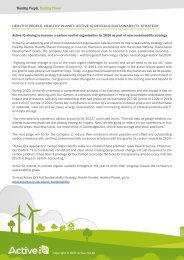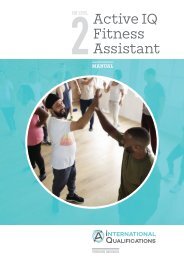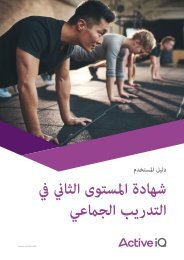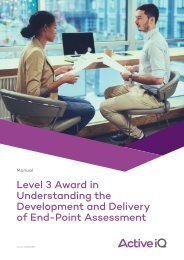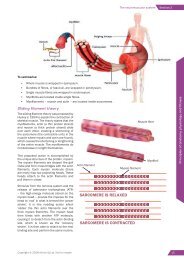Active IQ Level 3 Diploma in Supporting Clients with Long-term Conditions (sample manual)
For more information, please visit https://activeiq.co.uk/qualifications/level-3/active-iq-level-3-diploma-in-supporting-clients-with-long-term-conditions
For more information, please visit https://activeiq.co.uk/qualifications/level-3/active-iq-level-3-diploma-in-supporting-clients-with-long-term-conditions
You also want an ePaper? Increase the reach of your titles
YUMPU automatically turns print PDFs into web optimized ePapers that Google loves.
Manual<br />
<strong>Level</strong> 3 <strong>Diploma</strong> <strong>in</strong><br />
Support<strong>in</strong>g <strong>Clients</strong> <strong>with</strong><br />
<strong>Long</strong>-<strong>term</strong> <strong>Conditions</strong><br />
Version A<strong>IQ</strong>005801
The prevalence of long-<strong>term</strong> conditions<br />
Section 1<br />
The prevalence of long-<strong>term</strong> conditions<br />
The prevalence of people liv<strong>in</strong>g <strong>with</strong> long-<strong>term</strong> conditions (LTCs) is <strong>in</strong>creas<strong>in</strong>g, which is plac<strong>in</strong>g an ever-grow<strong>in</strong>g<br />
burden on health care and society, <strong>with</strong> current policies and care frameworks considered unsusta<strong>in</strong>able over the<br />
com<strong>in</strong>g years (NHS England, 2019).<br />
PREVALENCE OF LONG-TERM CONDITIONS<br />
AND THE SOCIOECONOMIC IMPACT<br />
<strong>Long</strong> Term <strong>Conditions</strong> are those that cannot, at present, be cured, but people liv<strong>in</strong>g<br />
<strong>with</strong> these conditions can be supported to ma<strong>in</strong>ta<strong>in</strong> a good quality of life.<br />
People over aged 85 years are<br />
more likely to be liv<strong>in</strong>g <strong>with</strong> a long<br />
<strong>term</strong> condition <strong>in</strong>clud<strong>in</strong>g fraility.<br />
% of population <strong>in</strong> England<br />
aged over 85 years<br />
4.1 4.2 4.4 4.6<br />
3.8<br />
3.3<br />
2.4 2.5 2.8<br />
1971<br />
1976<br />
1981<br />
1986<br />
1991<br />
1996<br />
2001<br />
2006<br />
2011<br />
People might be liv<strong>in</strong>g <strong>with</strong> more than one<br />
long <strong>term</strong> condition. Of the people who report<br />
that they live <strong>with</strong> long <strong>term</strong> conditions;<br />
24% have<br />
two long <strong>term</strong><br />
conditions…<br />
…and 20% more live<br />
<strong>with</strong> three or more<br />
long <strong>term</strong> conditions.<br />
18%<br />
of people<br />
liv<strong>in</strong>g <strong>with</strong> a long<br />
<strong>term</strong> condition<br />
smoke<br />
People who smoke<br />
are more likely to<br />
have flare ups <strong>in</strong><br />
their condition<br />
and more likely<br />
to be admitted to<br />
hospital.<br />
People liv<strong>in</strong>g <strong>with</strong> a long <strong>term</strong> condition<br />
are less likely to be work<strong>in</strong>g than the<br />
general population.<br />
People liv<strong>in</strong>g <strong>with</strong> a long <strong>term</strong> condition are more likely to use health and care<br />
services. They account for:<br />
More <strong>in</strong>formation about enhanc<strong>in</strong>g the quality of life for people liv<strong>in</strong>g <strong>with</strong> long <strong>term</strong> conditions can be found at www.england.nhs.uk/house-of-care/<br />
<br />
50%<br />
of all GP<br />
appo<strong>in</strong>tments<br />
64%<br />
of all hospital<br />
outpatient<br />
appo<strong>in</strong>tments<br />
70%<br />
of all hospital bed<br />
days<br />
The socioeconomic impact of LTCs<br />
70%<br />
of total health and<br />
social care spend<br />
72%<br />
of the general<br />
population are<br />
<strong>in</strong> work<br />
59%<br />
of people <strong>with</strong><br />
long <strong>term</strong><br />
conditions are<br />
<strong>in</strong> work<br />
35%<br />
of people<br />
<strong>with</strong> a mental<br />
health<br />
condition are<br />
<strong>in</strong> work<br />
Figure 1.2: Prevalence of LTCs and the socioeconomic impact (NHS England, 2019)<br />
Unsurpris<strong>in</strong>gly, people liv<strong>in</strong>g <strong>with</strong> LTCs make up a high proportion of those access<strong>in</strong>g health and social care services<br />
<strong>in</strong> the UK. There are some astound<strong>in</strong>g statistics regard<strong>in</strong>g the cost of support<strong>in</strong>g people liv<strong>in</strong>g <strong>with</strong> LTCs:<br />
The health landscape<br />
• For every £10 spent on health and social care, approximately £7 is spent on those liv<strong>in</strong>g <strong>with</strong> LTCs.<br />
• 50% of all GP appo<strong>in</strong>tments, 64% of outpatient appo<strong>in</strong>tments and 70% of all <strong>in</strong>patient bed days<br />
are for people liv<strong>in</strong>g <strong>with</strong> LTCs.<br />
• On average, it costs health and social care approximately £1,000 per year to support someone<br />
who does not have an LTC. This figure rises to £8,000 for those liv<strong>in</strong>g <strong>with</strong> three or more LTCs – an<br />
eight-fold <strong>in</strong>crease.<br />
NICE (2015)<br />
And from an economic perspective:<br />
• Work absence due to sickness costs the UK economy an estimated £22 billion per year, and<br />
although not all of this can be attributed to LTCs and an exact figure would be considered conjecture, it can<br />
still be accepted that a considerable proportion will be directly related (The Work Foundation, 2016).<br />
• For example, mental ill health, which sits under the LTC umbrella, cost the UK economy £25 billion*<br />
<strong>in</strong> lost productivity <strong>in</strong> 2015, <strong>with</strong> 17.6 million work<strong>in</strong>g days<br />
lost to mental illness (Oxford Economics, 2016).<br />
*This figure <strong>in</strong>cludes the cost of those unable to jo<strong>in</strong> the workforce due to<br />
mental ill health and those who have to reduce their work<strong>in</strong>g hours or leave<br />
employment entirely to care for someone <strong>with</strong> a mental illness.<br />
ACTIVITY<br />
Research the most<br />
recent statistics for the<br />
prevalence of long-<strong>term</strong><br />
conditions and compare<br />
these to global prevalence.<br />
Copyright © 2019 <strong>Active</strong> <strong>IQ</strong> Ltd. Not for resale 71
The prevalence of lifestyle behaviours associated <strong>with</strong> long-<strong>term</strong> conditions<br />
Section 2<br />
Smok<strong>in</strong>g<br />
It is now commonly accepted that smok<strong>in</strong>g is harmful to a person’s health and can <strong>in</strong>crease the risk of a range of<br />
LTCs. However, this was not always the case – <strong>in</strong> the first half of the 19 th century, cigarettes were actually promoted<br />
as a supplement to good health, as the images below show:<br />
As Figure 2.5 shows, current statistics <strong>in</strong> the UK suggest that the number of adults smok<strong>in</strong>g is decreas<strong>in</strong>g every<br />
year, <strong>with</strong> 19.8% (7.7 million) of the population smok<strong>in</strong>g <strong>in</strong> 2011, reduc<strong>in</strong>g to 14.9% (6.1 million) <strong>in</strong> 2017 – this<br />
equates to approximately 1.6 million fewer smokers.<br />
30<br />
UK, 2011 to 2017<br />
The health landscape<br />
20<br />
10<br />
0<br />
2011<br />
2012<br />
2013<br />
2014<br />
2015<br />
2016<br />
2017<br />
England<br />
Wales<br />
Scotland<br />
Northern Ireland<br />
United K<strong>in</strong>gdom<br />
Figure 2.5: Proportion who were current smokers, all persons aged 18 years and over<br />
(Annual Population Survey – Office for National Statistics)<br />
Copyright © 2019 <strong>Active</strong> <strong>IQ</strong> Ltd. Not for resale 79
Section 3<br />
Sociodemographic factors<br />
The follow<strong>in</strong>g <strong>in</strong>fographic adds further detail to the three de<strong>term</strong><strong>in</strong>ants of health identified above and <strong>in</strong>cludes some<br />
other important factors that <strong>in</strong>fluence the health of an <strong>in</strong>dividual.<br />
Income and social status<br />
There is a l<strong>in</strong>ear relationship between<br />
<strong>in</strong>come and social status, and health<br />
status – the more socially deprived,<br />
the poorer the health status, and vice<br />
versa. Higher <strong>in</strong>comes and social<br />
status are l<strong>in</strong>ked to better health.<br />
Education<br />
Societies <strong>with</strong> better education are<br />
more likely to have people liv<strong>in</strong>g more<br />
healthily, whereas lower education is<br />
associated <strong>with</strong> poor health.<br />
Physical environment<br />
Safe water, clean air and healthy workplaces all<br />
contribute to good health. Furthermore, people<br />
<strong>in</strong> employment are healthier, particularly those<br />
who have more control over their work<strong>in</strong>g<br />
conditions.<br />
Social support networks<br />
Greater support from families,<br />
friends and communities is l<strong>in</strong>ked to<br />
better health. Culture, customs and<br />
traditions, and the beliefs of the family<br />
and community, all affect health.<br />
Genetics and personal behaviour<br />
Hereditary factors <strong>in</strong>fluence lifespan, health<strong>in</strong>ess<br />
and the likelihood of develop<strong>in</strong>g certa<strong>in</strong> illnesses.<br />
Also, as already discussed, personal lifestyle<br />
behaviours play a significant part <strong>in</strong> de<strong>term</strong><strong>in</strong><strong>in</strong>g<br />
health, e.g. physical activity levels, diet, etc.<br />
Health care services<br />
Societies that offer better health<br />
care services have higher rates of<br />
mortality and better health overall.<br />
Gender<br />
Men and women suffer<br />
from different types of<br />
diseases at different ages.<br />
Figure 3.1: Factors that <strong>in</strong>fluence the health of an <strong>in</strong>dividual<br />
86<br />
Copyright © 2019 <strong>Active</strong> <strong>IQ</strong> Ltd. Not for resale
Behaviour change theories and techniques<br />
Section 1<br />
Maslow’s hierarchy of<br />
needs<br />
In 1943, Maslow suggested that there<br />
is a hierarchy of needs and that selfactualisation<br />
sits at the top. Before<br />
self-actualisation can be achieved, other<br />
needs take priority and these must be<br />
achieved first, as shown opposite.<br />
Formal theory<br />
Figure 1.4: Maslow’s hierachy of needs<br />
1. Cognitive evaluation theory (CET). This m<strong>in</strong>i-theory is concerned <strong>with</strong> <strong>in</strong>tr<strong>in</strong>sic motivation, def<strong>in</strong>ed as perform<strong>in</strong>g<br />
an activity or behaviour for its own sake or enjoyment. In other words, the activity itself is reward<strong>in</strong>g and no other<br />
reward is necessary. Spontaneous play is a good example of <strong>in</strong>tr<strong>in</strong>sically motivated behaviour <strong>in</strong> children. For adults,<br />
play may take on forms such as artistic, musical or literary creativity, or be demonstrated <strong>in</strong> sports or exploration.<br />
CET focuses most on the basic needs for autonomy and competence, and how these are supported or thwarted to<br />
generate or underm<strong>in</strong>e <strong>in</strong>tr<strong>in</strong>sic motivation (Deci, Koestner and Ryan, 1999).<br />
2. Organismic <strong>in</strong>tegration theory (OIT). Extr<strong>in</strong>sic motivations are the subject of this m<strong>in</strong>i-theory, although it is used<br />
as a blanket <strong>term</strong> for any behaviour that is performed <strong>in</strong> order to achieve an outcome outside of the behaviour<br />
itself. Extr<strong>in</strong>sic motivation is not a s<strong>in</strong>gle entity, but takes many forms <strong>in</strong>clud<strong>in</strong>g external regulation, <strong>in</strong>trojection,<br />
identification and <strong>in</strong>tegration. The important difference between the different types of extr<strong>in</strong>sic motivation is the<br />
degree to which a person <strong>in</strong>ternalises the motivation. The social environment is critical <strong>in</strong> de<strong>term</strong><strong>in</strong><strong>in</strong>g the degree of<br />
<strong>in</strong>ternalisation through the extent to which the basic needs of autonomy and relatedness are supported or thwarted.<br />
OIT therefore addresses the extent to which a social environment fosters or <strong>in</strong>hibits <strong>in</strong>ternalisation of extr<strong>in</strong>sic<br />
motivations (Ryan and Deci, 2000).<br />
Behaviour change for clients <strong>with</strong> long-<strong>term</strong> conditions<br />
Regulation Introjection Identification Integration<br />
Figure 1.5: Relationship between extr<strong>in</strong>sic motivation and autonomy and relatedness <strong>in</strong> environment<br />
Copyright © 2020 <strong>Active</strong> <strong>IQ</strong> Ltd. Not for resale 349
Behaviour change theories and techniques<br />
Section 1<br />
Motivators to behaviour change<br />
A key component of motivational <strong>in</strong>terview<strong>in</strong>g and other behaviour change techniques is a focus on the positive<br />
and avoidance of negative talk. Fitness professionals should latch on to the reasons why an <strong>in</strong>dividual would like to<br />
change their lifestyle behaviours for the better and use these to <strong>in</strong>crease the amount of ‘change talk’.<br />
Motivators for people <strong>with</strong> long-<strong>term</strong> conditions <strong>in</strong>clude:<br />
Be<strong>in</strong>g <strong>in</strong> less pa<strong>in</strong>.<br />
Be<strong>in</strong>g able to play<br />
<strong>with</strong> their children.<br />
Hav<strong>in</strong>g more<br />
energy and be<strong>in</strong>g<br />
happier.<br />
Improv<strong>in</strong>g<br />
confidence and<br />
self-esteem.<br />
Liv<strong>in</strong>g longer.<br />
Hav<strong>in</strong>g a better<br />
social life.<br />
Goal sett<strong>in</strong>g<br />
Avoid<strong>in</strong>g hospital<br />
admissions or<br />
hav<strong>in</strong>g to go <strong>in</strong>to a<br />
care home.<br />
Less reliance on<br />
medication.<br />
Avoid<strong>in</strong>g surgery.<br />
Figure 1.21: Examples of motivators to behaviour change <strong>in</strong> those <strong>with</strong> long-<strong>term</strong> conditions<br />
Behaviour change for clients <strong>with</strong> long-<strong>term</strong> conditions<br />
Goal sett<strong>in</strong>g has a pivotal role to play <strong>in</strong> successful behaviour change. There are strong l<strong>in</strong>ks between goal sett<strong>in</strong>g<br />
and develop<strong>in</strong>g self-efficacy. Goal sett<strong>in</strong>g is essential for the pac<strong>in</strong>g of programme developments and progressions;<br />
it also forms an important part of the review process and assists client motivation.<br />
Goals are <strong>in</strong>dividual to each person and the nature of their long-<strong>term</strong> condition(s), but it is likely that they will <strong>in</strong>clude<br />
one or more of the follow<strong>in</strong>g for most clients:<br />
• An improvement <strong>in</strong> overall health and quality of life.<br />
• A reduction <strong>in</strong> pa<strong>in</strong>.<br />
• An improvement <strong>in</strong> ability to function.<br />
• An adoption of suitable cop<strong>in</strong>g strategies.<br />
• The use of strategies to prevent the development of chronicity.<br />
• An <strong>in</strong>crease <strong>in</strong> knowledge and understand<strong>in</strong>g of symptoms. (CSP, 2006)<br />
Goals and objectives need to be agreed <strong>in</strong> partnership <strong>with</strong> the client, and stated <strong>in</strong> a language the client can<br />
understand.<br />
The fitness professional should also not assume what the client wants. Instead they should explore the client’s<br />
wants and needs and steer them towards a more active, self-management approach to their condition.<br />
Copyright © 2020 <strong>Active</strong> <strong>IQ</strong> Ltd. Not for resale 387
Section 2<br />
Lifestyle advice and education<br />
The guidel<strong>in</strong>es cover a range of population groups, <strong>in</strong>clud<strong>in</strong>g under-5s, children and young people (5–18 years),<br />
adults (19–64 years), older adults (65 years and over), pre and postnatal women and disabled adults. For the<br />
purpose of this qualification, this section will focus on adults and older adults.<br />
Figure 2.1: The current physical activity guidel<strong>in</strong>es for people aged 19 and older<br />
394<br />
Copyright © 2020 <strong>Active</strong> <strong>IQ</strong> Ltd. Not for resale
Section 2: Monitor<strong>in</strong>g and adapt<strong>in</strong>g physical activity programmes for clients <strong>with</strong> long-<strong>term</strong> conditions<br />
Unit 5<br />
Stages of monitor<strong>in</strong>g<br />
Monitor<strong>in</strong>g progress <strong>in</strong>cludes reviews and checks that are made:<br />
• Pre-session – before the session starts.<br />
• Mid-session – dur<strong>in</strong>g the exercise session.<br />
• Post-session – at the end of the session, when exercise has f<strong>in</strong>ished.<br />
Post-session checks<br />
Post-session checks will focus on client recovery (heart rate, blood pressure,<br />
etc) and gather<strong>in</strong>g feedback from clients to <strong>in</strong>form future sessions. The exercise<br />
referral <strong>in</strong>structor should discuss progress and developments <strong>with</strong> clients and<br />
agree any necessary adjustments to the exercise programme for next time.<br />
Post-session<br />
checks<br />
It may also be worthwhile us<strong>in</strong>g this time to advise clients of what they might<br />
expect over the 24–48 hours follow<strong>in</strong>g activity: muscle soreness, tightness,<br />
fatigue, fluctuations <strong>in</strong> energy levels, etc.<br />
Mid-session checks<br />
Dur<strong>in</strong>g exercise and throughout the exercise session, ongo<strong>in</strong>g<br />
monitor<strong>in</strong>g enables the exercise referral <strong>in</strong>structor to:<br />
• De<strong>term</strong><strong>in</strong>e how well clients are cop<strong>in</strong>g <strong>with</strong> the exercise<br />
programme.<br />
• Check how clients are feel<strong>in</strong>g about the exercise.<br />
• Identify any changes <strong>in</strong> clients’ response to exercise.<br />
• Identify any changes that need to be made to the exercise<br />
(regressions or progressions).<br />
• Provide cont<strong>in</strong>u<strong>in</strong>g help and support to clients.<br />
Different methods of monitor<strong>in</strong>g can be used dur<strong>in</strong>g the session (e.g.<br />
observation, question<strong>in</strong>g, RPE), which are discussed later <strong>in</strong> this unit.<br />
Pre-session checks<br />
Pre-exercise checks may <strong>in</strong>clude check<strong>in</strong>g for:<br />
• Contra<strong>in</strong>dications that present, e.g. high blood<br />
pressure or heart rate, or changes <strong>in</strong> condition<br />
(unstable).<br />
• Changes <strong>in</strong> the client’s health status, e.g. new<br />
symptoms, new medication or a deterioration of<br />
an exist<strong>in</strong>g condition (this may be uncontrolled or<br />
unstable).<br />
• Specific condition checks, e.g. availability of<br />
<strong>in</strong>halers or check<strong>in</strong>g pre-exercise blood sugar<br />
levels.<br />
• Confirmation of necessary medication – both<br />
its availability and that the client has taken it at<br />
the correct time prior to exercise, if appropriate.<br />
Pre-session<br />
checks<br />
STEP 1<br />
Mid-session<br />
checks<br />
STEP 2<br />
STEP 3<br />
Plann<strong>in</strong>g and adapt<strong>in</strong>g physical activity for clients <strong>with</strong> long-<strong>term</strong> conditions<br />
Any clients present<strong>in</strong>g <strong>with</strong> unstable or uncontrolled<br />
conditions or contra<strong>in</strong>dications should be signposted<br />
back to the GP for further checks prior to exercis<strong>in</strong>g.<br />
<strong>Clients</strong> <strong>with</strong>out appropriate medication should be<br />
advised to defer exercise.<br />
Figure 2.1: Session monitor<strong>in</strong>g steps<br />
Copyright © 2020 <strong>Active</strong> <strong>IQ</strong> Ltd. Not for resale 443




